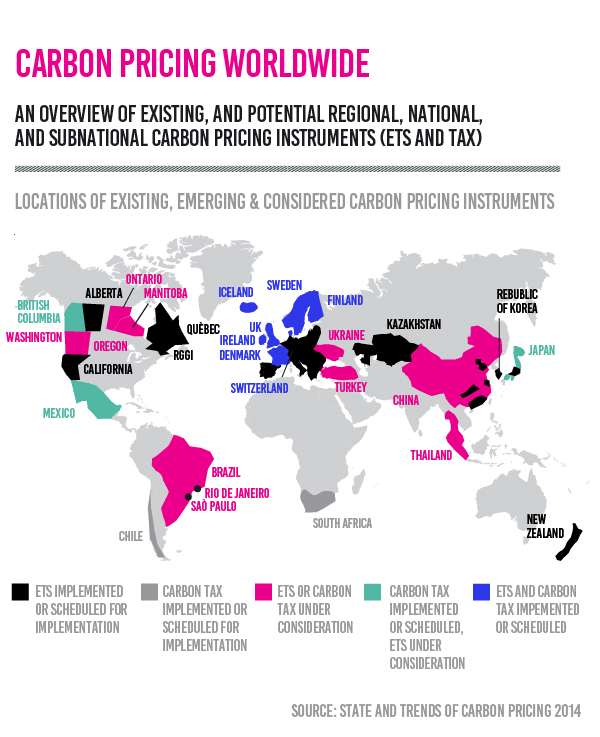![]() 6 minute read
6 minute read
Fortunately, the climate change problem discussion has started in Paris and already achieves the pragmatic solution steps in New York. The world is expected to get stricter environmental protection policies through carbon pricing. Besides the positive externalities, the tax expectation and implementation are resulting in the drop in fossil fuel prices. Moreover, understanding that carbon taxes will grow worldwide, the fossil producers are maximising the capacity in the attempt to sell more of the product right now. While fossil fuels are exhausted in nearest time, the low price triggers developing countries to overuse the oil. What policies should we wait for and how to manage the sustainable development of manufacturing? What Canada is to offer?
Consequences of Paris
round table
Elinor Ostrom, the Nobel laureate and economist, has stated earlier that solving the global carbon emission problem is a thorny way. In order to succeed, countries have to overcome the cooperation and free rider problem, manipulating both positive and negative incentives that way that everyone will have no other choice than to participate. The first step toward the sustainable future was to gather players at the round table – what Paris has triumphantly performed. Now we expect countries to sign the climate accord in the New York. By today, 130 countries have expressed their commitment by signing the pact. Nevertheless, the agreement should be approved and ratified which can take from months to years.
Today, about 40 countries and 23 cities and states worldwide have included carbon pricing policies in their agenda, covering about 12 percent of the world’s carbon pollution. Let’s look closer on the map to see the plans and ambitions of the global emissions cut plans.

From Nordics
to worldwide
Finland has the strictest environmental regulations in the world and the first country to present the carbon pricing back in 90’s. Carbon leakage from Scandinavia has spread to the whole Europe. Still, the two major contributors to global emissions level, the USA and China, are in the process of development of the regulations. The industries and businesses oppose the carbon pricing. Once two industrial countries commit to the common goal of the carbon emissions reduction, the climate change can be slowed down.
Besides the constraints of the carbon taxation, some found it as a business idea. For example, Greenstream specialises on emission reductions on the international level and has been involved in more than a hundred energy projects around the globe. One of the main services is providing carbon asset management, comprehensive services in the climate and renewable energy markets. Moreover, GreenStream Network has been selected to support the work of the Finnish Government in the Paris Convention on Climate Change further on negotiations and contract obligations in 2016. Besides, Chinese market became the target number one area for energy efficiency investments and [nbsp]delivering energy efficiency projects. China is expected to implement tight regulations on the carbon emissions as it is in Europe. Nordic excellence spreads not only to China but also leads Canada to the sustainable way.
Trudeau leading
the green tech
Charismatic prime minister of Canada is famous for his equality and sustainability attitudes and do not disappoint with his position about climate change. “Our government has heard loud and clear that Canadians care about standing up for our environment and our livelihoods,” states Justin Trudeau in New York. Canada, along with Chile, Ethiopia, France, Germany and Mexico, released the goal of reducing the global carbon emissions by 25 percent by 2020, and by 50 percent of emissions by 2050.
While in the USA some industries oppose the carbon taxation, Canadian manufacturing is fully on board supporting Trudeau’s initiative. Four of Canada’s provinces have already implemented the carbon pricing. Next step is carbon taxation on the national level. Luckily for the Canadian culture, high responsibility level and sustainable orientation of all actors, the cut of 50 percent of emissions seem valid. Let’ see what industries and businesses think of the additional taxation and other ways to help the country to meet the target.
Some companies prefer to implement the internal prices for the carbon which allows them to be prepared for[nbsp]the future policies. For example, according to CDP report, Cenovus Energy Inc. uses an internal carbon price model of $15–$65/tonne CO2e to project estimated compliance costs of GHG emissions over a 10-year plan.
Expanding the
forestry
Forest products industry volunteers to help the government to achieve the emissions cut with “30 by 30” climate change challenge. Forest Products Association of Canada recognises the importance and opportunities of the industry in the climate change as renewable forests and forest products all store carbon. The sector has estimated that up tp 30 MT can be reached by sustainable forest management maximising the carbon storage in the forests and by expanding the trees growth and territories. The secret of success is in close cooperation with the industry with the government. “30 by 30 is an important challenge, and one we have the determination to achieve. Our sector, in partnership with governments at all levels, has been able to accelerate our progress to reach our ambitious targets. We are ready to step up again and make a significant contribution to Canada’s climate goals” says Ted Seraphim, President and CEO of West Fraser.
The secret of
seven principles
The Mining Association of Canada (MAC) is on board tackling the climate change along with other industries. “Today, one of Canada’s largest industries is coming out in support of a carbon price, identifying it as the most effective and efficient means of driving emissions reductions and making real progress in the global fight against climate change,” stated Pierre Gratton, President and CEO, MAC. “MAC’s support of a carbon price is guided by our principles for climate change policy design, and is based on 16 years of our members’ continuous efforts to reduce emissions through technology and innovation and become more energy efficient.” The association has developed seven principles for climate change policy design. All of them are directed to prepare industry to aid reaching sustainable targets. First of them requires a broad-based carbon price. The second one requires to be revenue neutral and invest the revenues in the R[&]D of green and sustainable solutions. The third on is to address[nbsp]competitiveness and carbon leakage concerns across all sectors. This way it will be ensured that the investments, tax funds, and trade will not be in decline. Predictability, flexibility and ability to adapt goes as the fourth principle. The next one calls for the simple and easily implemented, and easily administrated solutions which will not over cross existing provincial schemes but compliment them. The sixth principle is to support investments through capital investments,[nbsp]which could involve public-private partnerships. And the last one is to “recognise early action, acknowledging that some companies have been proactive in reducing their climate footprints and that several provinces have already established climate change mitigation regimes.”




